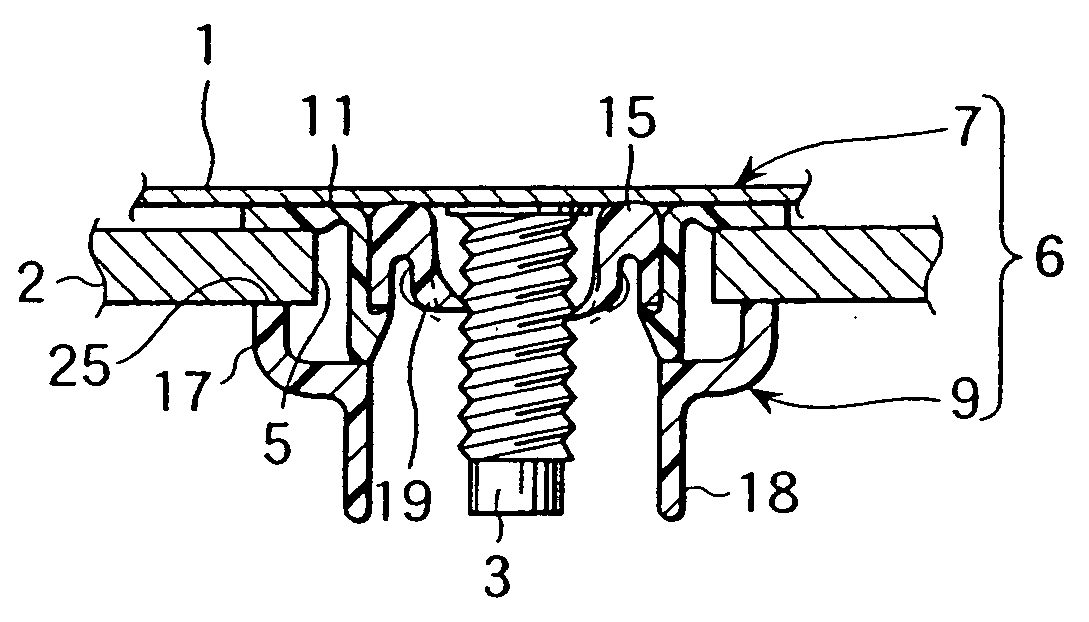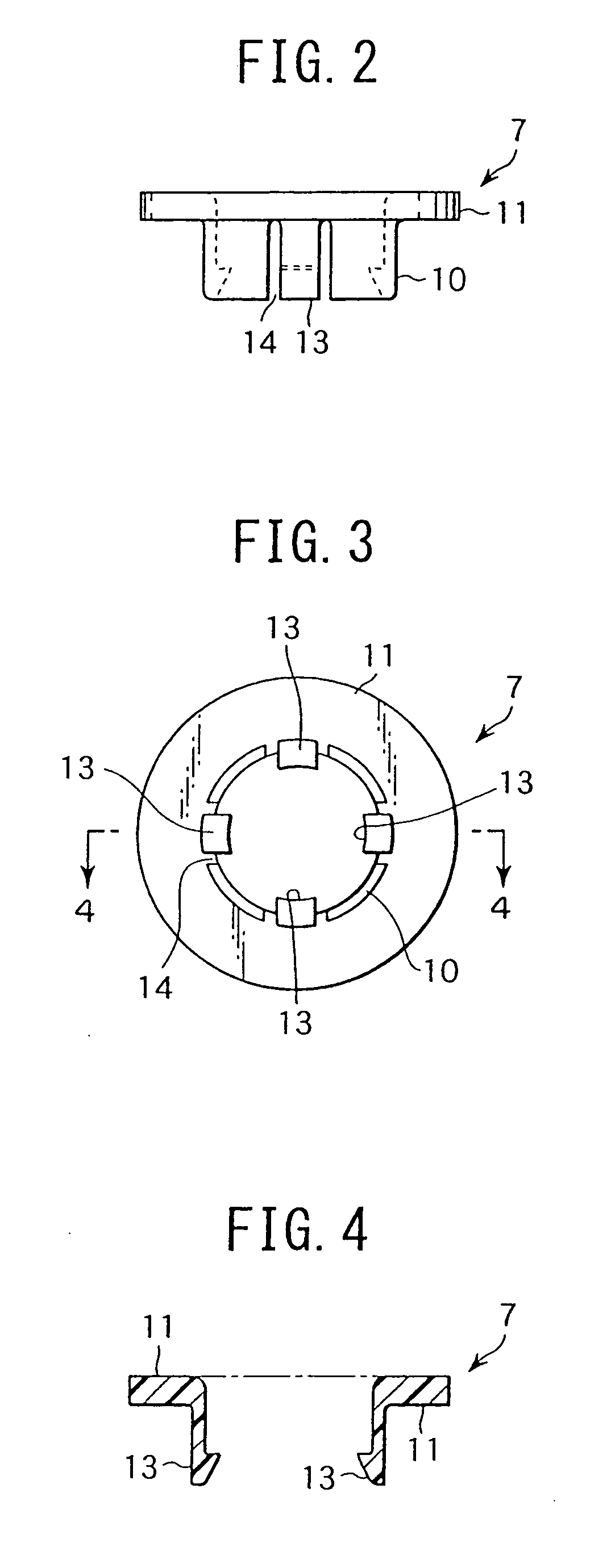[0008] It is therefore an object of the present invention to provide an undercover attaching apparatus and method that facilitate attaching an undercover and that allow the attached undercover to be desirably displaced along the underside of a floor panel due to
thermal expansion and contraction, thereby avoiding thermally-induced
distortion.
[0010] In one non-limiting embodiment of the invention, the
fastener comprises a first clip including an outer tubular portion adapted to be inserted into the mounting hole of the undercover; and a second clip including an inner tubular portion adapted to be inserted into the outer tubular portion of the first clip, and an engagement member such as a pawl or pawls adapted to be engaged with the stud. The first clip is formed with a first
flange adapted to be brought into contact with one side of the undercover when the outer tubular portion is inserted into the mounting hole; the second clip is formed with a second
flange adapted to be brought into contact with the other surface of the undercover when the inner tubular portion is inserted into the outer tubular portion; and the outer and inner tubular portions are formed with first and second
coupling portions for
coupling the outer and inner tubular portions to one another, whereby when the outer tubular portion is inserted into the mounting hole of the undercover and then the inner tubular portion is inserted into the outer tubular portion to couple the first and second clips together by the
coupling portions, the first and second flanges are brought into contact with respective sides of the undercover around the periphery of the mounting hole to clamp the undercover therebetween. The mounting hole of the undercover has a
diameter substantially larger than the outer
diameter of the outer tubular portion, providing diametral clearance that allows the undercover to be displaced along the underside of the floor panel due to its
thermal deformation, and the first and second clips are formed to allow the first and second flanges to clamp the undercover therebetween with a predetermined clamping force capable of clamping the undercover without its wobbling movement in the axial direction of the stud while allowing the undercover to be displaced along the underside of the floor panel due to
thermal deformation.
[0011] In the preferred method of the invention, the fasteners are fastened to the undercover in advance of installing the undercover on a floor panel, making it possible to readily carry the undercover with the fasteners held thereon. Thus, the undercover can be attached to the underside of the floor panel of a car body by a simple attaching operation of properly positioning the undercover with the fasteners to the underside of the floor panel and then pressing the undercover to the underside of the floor panel while inserting the studs into the fasteners. Further, the first and second clips are formed so that the first and second flanges clamp the undercover therebetween with a predetermined clamping force that prevents wobbling movement of the undercover in the axial direction of the studs while allowing the undercover to be displaced along the underside of the floor panel due to its thermal deformation, and thereby to eliminate
distortion of the undercover around the studs.
[0012] Preferably, the studs are threaded studs, and in one embodiment the second clip includes the inner tubular portion having a stud engagement pawl or pawls formed in the inside thereof; the second
flange is formed at one of the ends of the inner tubular portion, and a polygonal tubular portion extends from the second flange as an extension of the inner tubular portion. This polygonal tubular portion may be formed as a tubular body having an inner
diameter greater than the outer diameter of the thread of the stud, so as to allow the polygonal tubular portion to be free from engagement with the thread of the stud. The polygonal tubular portion can be rotated about the axis of the stud by a tool, so as either to provide tighter fastening of the engagement pawl on the stud or to release the fastening.
[0014] Furthermore, a portion of the outer tubular portion may be divided by axially extending slits to form a first coupling portion of the first clip, and the outer surface of the inner tubular portion can be formed with a second coupling portion adapted to be engaged with the first coupling portion. The first and second coupling portions are formed to allow the first and second flanges to be spaced apart from each other by an
axial distance equal to or slightly less than the thickness of the undercover so as to provide a predetermined clamping force when the first and second coupling portions are engaged with one another.
[0018] Furthermore, the inner tubular portion of the second clip may have an
axial length which allows the first flange to be brought into contact with the underside of the floor panel and allows the second flange to press the undercover, when an end of the inner tubular portion is brought into contact with the underside of the floor panel by the rotation of the polygonal tubular portion. According to this structure, the undercover can be firmly attached to the underside of the floor panel while limiting the clamping force to within a certain range that allows the undercover to be displaced along the underside of the floor panel due to thermal deformation.
 Login to View More
Login to View More  Login to View More
Login to View More 


